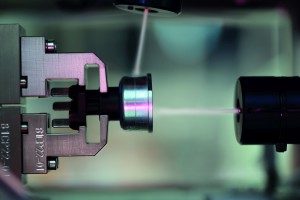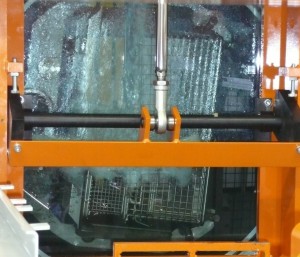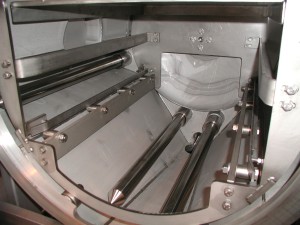There is hardly a sector in which parts cleanliness has not become a mission-critical requirement. Meeting the stipulated demands can take significant effort, and at the same time there is a great need to cut costs. It is therefore essential to fully leverage optimization potential in parts cleaning.
 Parts cleaning as a value-added manufacturing step? The rising requirements for technical cleanliness of parts in nearly all industrial sectors in recent years mean that industrial parts cleaning provides added value. Because in many cases the quality of subsequent processing steps as well as of the final product is highly dependent on the cleanliness of the parts. There is no single recipe for meeting defined cleanliness specifications consistently and efficiently, because every cleaning task requires an individually tailored solution. The industry offers a variety of processes, which can also be used in combination with one another.
Parts cleaning as a value-added manufacturing step? The rising requirements for technical cleanliness of parts in nearly all industrial sectors in recent years mean that industrial parts cleaning provides added value. Because in many cases the quality of subsequent processing steps as well as of the final product is highly dependent on the cleanliness of the parts. There is no single recipe for meeting defined cleanliness specifications consistently and efficiently, because every cleaning task requires an individually tailored solution. The industry offers a variety of processes, which can also be used in combination with one another.
Wet chemical cleaning – the medium is the key
For machined parts as well as formed parts, wet chemical cleaning is the most commonly used technology in the metalworking industry. In selecting the cleaning medium, it is advisable to follow the chemical principle of “like dissolves like.” In other words, for mineral oil based (non-polar) contaminants such as machining oil, grease or wax, a solvent is generally the right choice. To maintain an oil-free surface, solvents are often used for cleaning before coating or heat treatment.
Aqueous cleaners are customarily used for water-based (polar) contaminants such as cooling and lubricating emulsions, polishing compounds, additives, salts, abrasion and other solids.

Cleaning efficiency – a question of both medium and process engineering
To achieve the required result quickly with wet chemical cleaning processes, the effectiveness of the medium is enhanced by physical process engineering methods. Frequently used methods include spraying, immersion, ultrasonic and pressure deluge.
In spray cleaning the medium is sprayed under high pressure onto the surface to be cleaned using nozzles, at 6 to 8 bar for general cleaning or 20 to 25 bar for targeted cleaning. Contaminants are in part removed or emulsified by the chemical action of the medium, and in part washed away by the high kinetic energy of the spray jet. The shape and arrangement of the nozzles and the spray pressure determine the effectiveness of spray cleaning. To ensure even cleaning of all part surfaces, it may be necessary to move parts and/or nozzles.
Parts with complex geometry, such as blind holes or indentations, are better cleaned using a cleaning bath. The cleaning medium chemically removes contaminants from the part when it is immersed in the cleaning bath. Spinning or moving the parts from side to side in the bath enhances the cleaning effect.
Immersion is also the basis for ultrasonic cleaning, which can achieve very high cleanliness in relatively short treatment times. The cleaning efficiency is based on a physical effect known as cavitation: the strong suction phase of the acoustic wave front ruptures the liquid, forming millions of microscopic bubbles. During the subsequent pressure phase, the cavitation bubbles become unstable and implode. This creates high-energy shock waves that dislodge the particles and film residue from the parts being cleaned. Microcurrents formed in the liquid also rinse away detached or dissolved contaminants. These effects not only remove contaminants from the surface, but also from complex geometries, cavities, drill holes and microstructure fissures. The ultrasonic frequency plays a decisive role in the cleaning result. In general, the lower the frequency, the higher the energy released by the sound waves.

ressure flooding is also performed in an immersion bath. Pumps suck liquid out of the bath and then reinject it under high pressure via a nozzle system below the surface of the liquid. This forms strong currents in the bath, creating turbulence at the part edges that removes the contaminants. Currents flowing past blind holes and indentations also create a suction effect that pulls out contaminants deposited inside.
These processes are often used in combination, in particular in single-chamber cleaning systems. Key factors in selecting a wet chemical cleaning process are part geometry, material, type and degree of contamination, cleaning medium, process, length of treatment, number of process steps, throughput and cleanliness requirements. Trial cleaning in the system or media manufacturer’s workshop using real contaminated parts helps to determine the precise parameters.
CO2 – an ice-cold and easy-to-automate alternative
In CO2 snow blast cleaning, liquid carbon dioxide serves as the cleaning medium. It is a byproduct of chemical processes and

biomass energy production, for an environmentally neutral cleaning process. The carbon dioxide is forced through a nozzle and turns to fine snow crystals when it emerges. These are focused and sprayed at supersonic speed by compressed air. When the high pressure snow stream hits the surface to be cleaned, a combination of thermal, mechanical, sublimation and solvent effects occurs. These effects remove particulate and film contaminants from nearly any material in a dry and residue-free process, so this process can be used to clean entire parts, such as bumpers, before painting. It also makes it possible to target defined functional areas such as sealing, adhesive, welding, bonding and measuring surfaces, without the entire part needing to be brought to the cleanliness level required for the functional surface. Additional advantages are compact design and easy automation using adapted parts handling.
The international trade fair for industrial cleaning of parts and surfaces
How can the cleaning process be optimally adapted to the task? Which methods can be easily integrated into automated processes? Answers to these and many other questions about parts cleaning offers parts2clean. The international trade fair for industrial parts and surface cleaning takes place from 31 May to 2 June 2016 at the Stuttgart exhibition center (Germany). The exhibition portfolio includes cleaning systems, cleaning media, quality assurance and test methods, cleaning and transport containers, disposal and recycling of process media, and much more. www.parts2clean.com.



